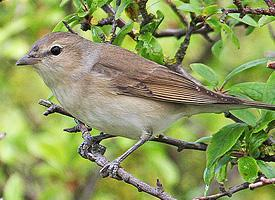
Váhy a míry
| Délka | od 13 do 14 cm |
|---|---|
| Hmotnost | od 12 do 16 g |
| Délka rozpětí křídel | od 17 do 20 cm |
Popis zvířete
The Lesser Whitethroat, scientifically named Sylvia curruca, is a small and fascinating bird species that belongs to the Sylviidae family, which encompasses various warblers. This bird is particularly notable for its distinctive appearance and melodious song, making it a subject of interest among birdwatchers and ornithologists alike.Characterized by its compact size, the Lesser Whitethroat typically measures about 12.5 to 14 cm in length, with a wingspan ranging from 18 to 23 cm. This bird exhibits sexual dimorphism, which means males and females can be slightly different in appearance, although these differences are subtle in this species.
The plumage of the Lesser Whitethroat is predominantly grey and white, providing it with excellent camouflage in its natural habitat. The upper parts of the body, including the back and wings, are a sleek grey, blending seamlessly into lighter environments. The underparts are a clean white, adding to its inconspicuous appearance. A distinguishing feature of this bird is the whitethroat itself—a bright white patch that stands out against the grey head. The bird also has a dark cheek patch, which contrasts with the white throat, and reddish-brown wing patches that can be seen during flight.
Lesser Whitethroats have a wide distribution, primarily found across Europe and Asia. They are migratory birds, spending the breeding season (spring and summer) in temperate regions and migrating to warmer climates in Africa and the southern parts of Asia for the winter. Their preferred habitats include open woodlands, thickets, hedges, and scrublands, where they can find ample food and nesting sites.
Diet-wise, these birds are primarily insectivorous, feeding on a variety of insects and spiders. During the breeding season, their diet may also include berries and other small fruits, supplementing their nutritional intake to meet the demands of raising their young.
The song of the Lesser Whitethroat is a distinctive and pleasant sound, often described as a rapid, chattering melody interspersed with clearer notes. This song plays a crucial role in territorial displays and attracting mates during the breeding season.
Breeding behavior is typical of many small passerines. The female builds a cup-shaped nest hidden in dense vegetation, where she lays 4 to 6 eggs. Both parents participate in feeding the chicks, which fledge about two weeks after hatching.
Despite facing threats from habitat loss and changes in agricultural practices, the Lesser Whitethroat has maintained a stable population across much of its range. It is classified as Least Concern by the International Union for Conservation of Nature (IUCN), indicating that it is not currently at significant risk of extinction.
In summary, the Lesser Whitethroat is a small, unassuming bird with a remarkable ability to blend into its surroundings. Its beautiful song, migratory habits, and adaptability to various habitats make it a captivating subject for study and observation in the natural world.
Podobná zvířata
Nové fotografie zvířat
Top 10 zvířat
- Dolphin gull (Leucophaeus scoresbii)
- Diana monkey (Cercopithecus diana)
- Moustached guenon (Cercopithecus cephus)
- Galápagos tortoise (Geochelone nigra complex)
- Stone loach (Barbatula barbatula)
- Japanese macaque (Macaca fuscata)
- Russian tortoise (Testudo horsfieldii)
- Greek tortoise (Testudo graeca)
- Common flying dragon (Draco volans)
- Vendace (Coregonus albula)


